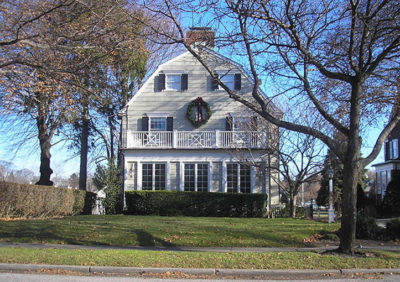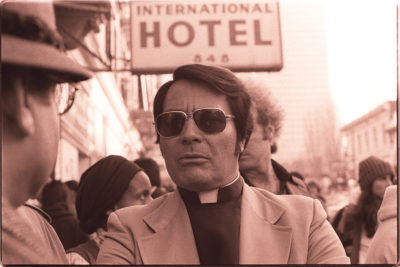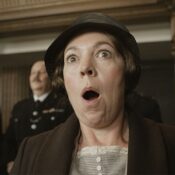Horror fans know that terror can come from anywhere. It doesn’t have to come from a spooky castle or an ancient city under the sea. Sometimes, the most terrifying things can be right outside your window. In that (Halloween) spirit, we’re taking a look at some of the scariest films that are all the more frightening for being based on true events.
Psycho (1960) and The Texas Chainsaw Massacre (1974)
When Robert Bloch was writing the novel, Psycho, in Weyauwega, Wisconsin, he had no idea that a similar, real-life horror was playing out roughly 40 miles away. Handyman Ed Gein was arrested in 1957 for the murders of two women, but the details of Gein’s life and actions were even more disturbing. Gein had been a grave-robber as well, and he used the remains from local cemeteries to make things like lampshades and masks from human skin. He’d also been in the process of making a human skin-suit when he was arrested; he wanted to wear it in order to, by his own admission, become his late mother. Bloch was amazed by the similarities of his character Norman Bates and his real-life counterpart, and even inserted a reference to Gein near the end of the novel before it was completed.
Released in 1959, the book was adapted into the classic film by Alfred Hitchcock the following year. Gein’s crimes inspired a number of other horror films and characters, the most notable of which is possibly Tobe Hooper’s The Texas Chainsaw Massacre. Though The Silence of the Lambs, Three on a Meathook, and others invoke Gein in various ways, Hooper has noted repeatedly over time that his villain Leatherface and other plot details were directly inspired by Gein.
The Exorcist (1973) and The Exorcism of Emily Rose (2005)
Many critics consider The Exorcist one of the most frightening films ever made. Masterfully directed by William Friedkin, the film shattered a number taboos as it presented a challenging, and often grueling, look at the idea of supernatural evil. The United States Conference of Catholic Bishops actually addressed the subject of exorcism as recently as 2014, detailing how and under which circumstances such a rite can be performed. The Exorcist itself and its source novel by William Peter Blatty were inspired by the story of Roland Doe from 1949. Doe, a 14-year-old boy, underwent a series of exorcisms for demonic possession, though much later research and reporting makes the case that the boy’s various afflictions were earthly maladies. Another tale of exorcism, 2005’s The Exorcism of Emily Rose, was based on the Anneliese Michel case. In this case, a young German woman died after undergoing the rites, resulted in convictions of negligent homicide for her parents and two priests.
The Town That Dreaded Sundown (1976)
Considered an early entry in the slasher genre, The Town That Dreaded Sundown presents a fictionalized version of real events that occurred in and around Texarkana, Texas in 1946. That case revolved around the “Phantom Killer,” a man that wore a white cloth mask; he attacked eight people over a span of multiple assaults, leaving only three alive. Though authorities believed they had a possible suspect, no one was ever convicted. The film takes several liberties with the stories and the backgrounds of the townspeople (whose names were changed), but it’s powered by interesting direction from Charles B. Pierce that builds an effective movie. Unfortunately, Pierce throws in some ill-advised comedy at too many junctures. The film was remade in 2014.
The Amityville Horror (1979)

The Amityville Horror is one of the most divisive horror films of all time. Based on the 1977 book by Jay Anson, the story has drawn criticism from observers who are convinced that the story of a family driven from a haunted house was a hoax. Noted paranormal investigators Ed and Lorraine Warren, who participated in examining the house, always insisted it was all true In his book Danse Macabre, Stephen King theorized that the dread of having your house turn on you in what was an uncertain economic time in America contributed to its popularity, despite some problems in execution.
The haunting and possession stories arose from grisly events. In 1974, six members of the DeFeo family were murdered in the house; sole survivor Ronald DeFeo, Jr. later admitted to the killings and was convicted. The Anson book asserts that the murders led to the haunting of the home. As of this writing, DeFeo is still alive, serving six concurrent sentences of 25 years to life.
Open Water (2003)
If you have a deeply rooted fear of being eaten by a shark, you should probably skip this paragraph. Open Water tells the story of a couple who are left behind during a scuba drive. Inevitably, the sharks come, and bad things happen. That’s an unsettling thing to ponder, but the worst part is that the movie is based on the true story of a real couple who were left behind on a diving trip in 1998. Their names were Tom and Eileen Lonergan, and the boat left without them during a dive off of the Great Barrier Reef in Australia. Though some gear and a diving slate with a distress message written on it were found, their bodies were never recovered. In the real case, there are multiple theories as to what ultimately happened to the Lonergans. In Open Water, the fate of the two leads is far less ambiguous; it’s definitely sharks.
The Girl Next Door (2007) and An American Crime (2008)
Not to be confused with the teen comedy of the same, The Girl Next Door relates a fictionalized account of one of the most tragic true stories to ever take place. The film is based on the novel by noted horror writer Jack Ketchum, who tells the story of the ongoing imprisonment and torture of two girls by their aunt and three male cousins. It’s horrific in its detail, but what’s far worse is that the telling is very clearly close to the truth of the actual Sylvia Likens case. In Indianapolis in 1965, Likens was tortured over a period of three months by Gertrude Baniszewski, whom Likens’ parents were paying to board the young girl while her mother served jail time and her father worked for traveling carnivals. Baniszewski, her daughter, her son, and two boys in the neighborhood would eventually be tried and convicted for the murder of Likens. A film version of the story that used the real names of the people involved, An American Crime, debuted on Showtime in 2008; Catherine Keener received Golden Globe and Emmy nominations for her portrayal of Baniszewski, and the film was nominated for a Writers Guild of America Award.
The Strangers (2008)
One of the creepiest of all modern horror films has its roots in a bizarre case that still remains officially unsolved. The plot of The Strangers turns on three masked attackers perpetrating a home invasion at a couple’s vacation house. Writer-director Brian Bertino said that he based the story on true events, in part the Tate murders committed by members of the Manson Family in 1969.
Many critics and film scholars believe that another primary inspiration came from the so-called Keddie cabin murders, also known as the Cabin 28 murders. In 1981, Sue Sharp and her children were staying in a cabin in Keddie, California. Daughter Sheila spent the night with friends at another cabin, and returned home to find her mother, Sue, two of her brothers, and a brother’s friend murdered. Her teen sister was missing; her two youngest brothers and another friend were in bedroom unharmed. Police found the knives and a hammer used in the killings, but wouldn’t find the missing daughter’s remains until they were discovered at a different campsite three years later. Although there were suspects, no one was ever tried; however, as recently as April 2018, a special investigator alluded to having DNA evidence that matched a living suspect.
The Haunting in Connecticut (2009)
Welcome to Southington, Connecticut, where we once again find our old friends Ed and Lorraine Warren. The previously mentioned paranormal investigators have begun to figure into more cinema in recent years, in part because of the large reservoir of cases that they’ve been involved with over the decades. As those stories have been adapted in larger numbers, their pop culture presence has continued to grow. The Haunting in Connecticut is based the 1986 story of the Snedeker family; it involves allegations of necromancy, a haunting, an exorcism, and a house that was once a funeral home. Noted horror novelist Ray Garton wrote a book about the case in 1992 called In a Dark Place: The Story of a True Haunting, but he has since distanced himself from his account; both Garton and writer-debunker Benjamin Radford allege that the Warrens coached Garton to amplify the story. Nevertheless, many media entities have treated that version seriously and covered it on TV programs like A Haunting and Paranormal Witness.
The Sacrament (2013)
The multi-hyphenate talent Ti West, along with frequent collaborator Joe Swanberg, is part of the younger wave of American horror. Using a found-footage approach, West wrote, directed, edited, and produced the film based on one of the darkest chapters in recent American history: the tragedy at the Peoples Temple Agricultural Project, better known as Jonestown. In the film, a photographer attempts to investigate the mysterious commune where his sister is living; he takes along some co-workers as a film crew to document the experience in this supposedly utopian settlement. As you might expect, things go very badly.

The original Jonestown settlement founded by Jim Jones in Guyana met its dire fate 40 years ago in November of 1978. After an investigatory visit from a delegation led by Congressman Leo Ryan, a member of the settlement passed along a note saying they wanted help getting out. The Ryan delegation went to the airport with a few defectors the next day; unfortunately, Jones ordered an ambush of Ryan and his group. Ryan, NBC reporter Don Harris, NBC cameraman Bob Brown, San Francisco Examiner photographer Greg Robinson, and Patricia Parks were shot and killed, and several others were wounded. Back at Jonestown, Jones ordered his followers to consume cyanide-laced drinks to commit “revolutionary suicide.” At least 907 people died from poisoning (including many children whose parents gave them the poison). Jones took his own life by gunshot. Between the airport, the settlement, and other, related acts of violence, 918 people died.
The Conjuring (2013)
The major success of The Conjuring in 2013 led to two direct sequels, the Annabelle spin-offs, and The Nun, with more, like The Crooked Man, possible. The film that started it all was directed by James Wan, who has become a force in Hollywood; it addition to co-creating the Saw franchise and directing its first film, Wan also directed Furious 7, Aquaman, Insidious and its first sequel, and produced the other entries in the Conjuring Universe.
The basic plot of The Conjuring involves a Rhode Island case that the Warrens took on in 1971; their investigation eventually led them to perform an exorcism. While disputes about the factual nature of the case versus the film always occur, the film itself was a hit with critics and audiences alike, planting a firm foundation for the other films to follow.
It’s easy to be dismissive about tales of hauntings and possessions in the harsh light of day. The vast majority of such cases tend to be debunked or easily explained with a little study and a little science. But every once in a while, something comes along that defies an easy answer. In those moments, in the dark, it’s easy to see how the things that might be true can be the most frightening.
Featured Image: Anthony Perkins as Norman Bates in Psycho. (©Paramount Pictures)
Become a Saturday Evening Post member and enjoy unlimited access. Subscribe now



